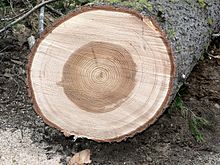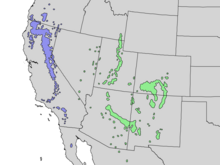Colorado Fir
| Colorado Fir | ||||||||||||
|---|---|---|---|---|---|---|---|---|---|---|---|---|

Colorado fir, branches with cones |
||||||||||||
| Systematics | ||||||||||||
|
||||||||||||
| Scientific name | ||||||||||||
| Abies concolor | ||||||||||||
| ( Gord. Et Glend. ) Lindl. ex Hildebr. |
The Abies concolor ( Abies concolor , too) Gray fir mentioned, is a plant of the genus of fir ( Abies ) in the family of Pinaceae (Pinaceae).
description
Habitus
The Colorado fir is an evergreen, relatively fast-growing tree that reaches stature heights of over 50 meters and a trunk-height trunk diameter ( BHD ) of over 150 centimeters. The tallest known Colorado fir measures 58.5 meters and has a trunk diameter of 271 centimeters. Abies concolor var. Concolor remains smaller, for the variety stature heights of up to 41 meters and a BHD of up to 124 centimeters are given. Strong old fir trees are sometimes used by bears as winter quarters. The crown shape is pyramidal and harmonious. The branches branching off horizontally from the trunk are characteristic. Solitary trees are branched to the ground.
Needles and twigs
The 5 to 7.5 centimeters long, blue-green needles on both sides that stick out like a comb from the branch and fall off after about eight to ten years are striking. Especially on the top of the branch , they are slightly curved upwards and curved forward. The needles are the longest of all types of fir. The branches are relatively strong, initially smooth and light gray in color, later rough and gray to gray-brown. The needles smell of grated lemon.


Bark and wood
The bark is light gray and becomes furrowed and corky towards the base. It can be up to 16 centimeters thick at the base of the trunk. While young trees have a smooth bark, old Colorado firs form irregular, plate-like scales. The wood is light and soft, also quite coarse-grained and not very durable. The wood color varies between whitish and light brown, with no difference between sapwood and heartwood . It has a bulk density of 400 to 420 kg / m³.
root
Seedlings form a taproot , which is not common on old trees. The species develops a deep root system in deep soils. The only known mycorrhizal partners are Cenococcum geophilum and the common pea litter ( Pisolithus arhizus ).
Flowers, cones and seeds
This monoecious ( monoecious ) species does not become male (sexually mature) until the age of about 30 to 40 years. Then the red or pink male cones, about 1.6 centimeters long, appear in the leaf axils of previous year's branches. These are located in the middle and lower crown area. The female cones can be found in the upper third. They stand upright, are partly yellow-green, partly red and about 3.5 centimeters long. The flowering period extends from May to July, depending on the region.
The seeds are ripe in September and October . The cylindrical cones are then 7.5 to 13 centimeters in size and have a light brown color. The winged seeds fall to the ground with the cone scales. The seeds are 8 to 12 millimeters long and have wings 1.5 to 1.8 centimeters wide. The thousand grain weight is between 25.6 and 52.9 grams. Squirrels bury entire cones for food, which often results in natural regeneration groups. Foresters use these buried cones as a source of seeds.
Chromosome number
The number of chromosomes is 2n = 24.
Occurrence
The Colorado fir has its natural range in western North America. The variety Abies concolor var. Concolor colonizes altitudes of the Rocky Mountains from 2100 m to 2700 m, while Abies concolor var. Lowiana more on mountains near the Pacific coast at altitudes between 1200 m and 2100 m in the Sierra Nevada and between 1500 m and 3000 m in the San Bernardino Mountains in Southern California can be found. The Abies concolor var. Concolor represents the climax tree species in the southern Rocky Mountains . The north and east sides of the mountains of Oregon and California seem to be optimal for their development .
In temperate climates, the Colorado fir tree is widespread as a park and garden tree, as it only makes low demands on the location and tolerates drought and frost . That is why it is considered one of the best city firs. Forestry trial crops in Germany were unsuccessful.
The optimum of the Colorado fir is for the variety Abies concolor var. Concolor in areas with precipitation from 510 to 890 mm, for the variety Abies concolor var. Lowiana from 890 to 1900 mm. Both varieties are extremely insensitive to long winters. It withstands temperatures of -39 ° C and +38 ° C. Among the fir species, the Colorado fir is considered to be the most insensitive to drought. It makes very little demands on the soil and the pH value .
Systematics
The specific epithet concolor means “same color” and indicates the needles of the same color on both sides.
The Colorado fir is divided into the two varieties Abies concolor var. Concolor , the "inland form" and Abies concolor var. Lowiana , the "Sierra form". Some authors also see them as separate species: Abies concolor and Abies lowiana (Gordon) A. Murray bis .
- Colorado fir ( Abies concolor var. Concolor ): It reaches an average height of 33 meters and is frost hardy and slow-growing. Has bluish gray-green, vertically arranged needles. It occurs from Colorado , southeast Idaho and eastern Nevada through eastern California , Arizona and New Mexico to northern Mexico .
- Sierra fir ( Abies concolor var. Lowiana (Gordon) Lemmon ; Syn .: Picea lowiana Gordon , Abies lowiana (Gordon) A. Murray bis ): This fast-growing variety reaches heights of over 50 meters. The needles, which are lighter green on the underside, are parted horizontally. It occurs in the California Coast Mountains, southern Oregon, and the Sierra Nevada .
Phytopathology
Bark beetle populations in particular are decisive in terms of phytopathology and forestry in the Colorado fir . In the natural area it is often attacked by pine cancer and dwarf mistletoe ( Arceuthobium ). Furthermore, it is severely dogged by game . Fire has the greatest significance of abiotic forest damage . It is moderately sensitive to ozone , completely insensitive to frost. It can withstand extreme temperatures of -39 ° C.
use
Due to the rather poor quality of the wood, there is only little suitability for timber. Mostly the wood is used to make boxes or as a construction element for small houses. The fir is used as a pulp supplier for paper production and as plywood .
The Colorado fir is used as an ornamental wood because of its modesty .
In America it is often used as a Christmas tree and is therefore grown in plantations . The resin that emerges from the bark of young trees is used to make Canada balsam .
swell
- Christopher J. Earle: Abies concolor. In: The Gymnosperm Database. May 22, 2011, accessed October 22, 2011 .
- Peter Schütt: Abies concolor . In: Peter Schütt, Horst Weisgerber, Hans J. Schuck, Ulla Lang, Bernd Stimm, Andreas Roloff: Lexicon of Conifers. Distribution - Description - Ecology - Use; the great encyclopedia . Nikol, Hamburg 2004, ISBN 3-933203-80-5 , p. 35-44 .
- Jost Fitschen, Franz H. Meyer [arrangement]: Woody flora: a book to determine the trees and bushes that grow wild and are planted in Central Europe; with bud and fruit key . 11th, adult and corr. Edition. Quelle and Meyer, Wiebelsheim 2002, ISBN 3-494-01268-7 .
- David More, John White, Joachim Mayer [transl.]: Colorado fir . In: The Cosmos Encyclopedia of Trees: 2100 species and varieties . Kosmos, Stuttgart 2005, ISBN 3-440-10170-3 , pp. 143 .
Individual evidence
- ^ Abies concolor (Gordon & Glend.) Lindl. ex Hildebr. at Tropicos.org. Missouri Botanical Garden, St. Louis.
- ^ John W. Thieret: Abies lowiana . In: Flora of North America Editorial Committee (Ed.): Flora of North America North of Mexico . Volume 2: Pteridophytes and Gymnosperms . Oxford University Press, New York / Oxford a. a. 1993, ISBN 0-19-508242-7 (English).
Web links
- Abies concolor in the endangered Red List species the IUCN 2006. Posted by: Conifer Specialist Group, 1998. Retrieved on 12 May, 2006.
- Thomas Meyer: Data sheet with identification key and photos at Flora-de: Flora von Deutschland (old name of the website: Flowers in Swabia )



